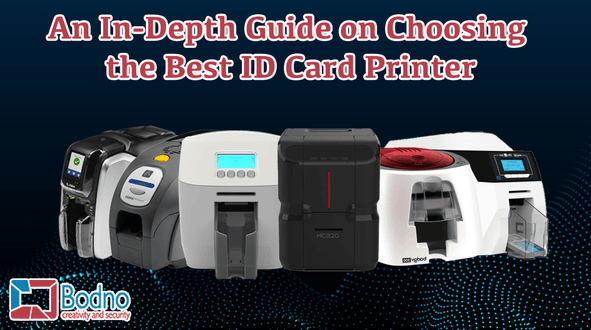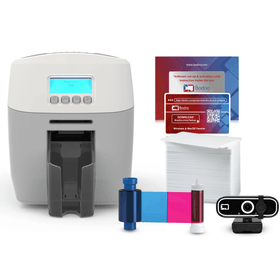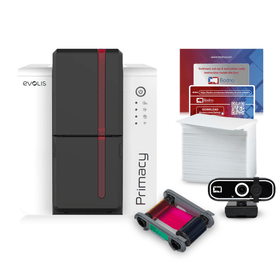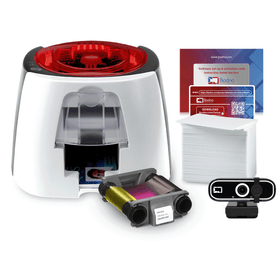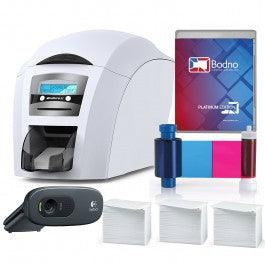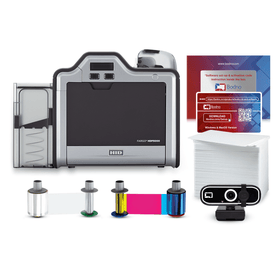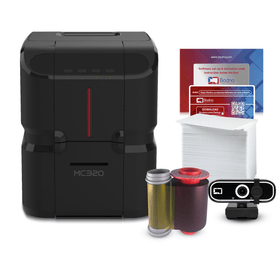Choosing an id card printer carefully is important to your institution or business for a range of reasons. You know your business best, but there are seemingly endless options to choose from so it can be a difficult task to undertake. It can be helpful to organize your goals when considering which id printer to purchase. First, consider the volume at which you will need to utilize your card printer. Once this has been determined, you will want to consider what type of security features you're looking for in an ID badge. Next, consider design needs, wants, abilities and constraints. After this, it is helpful to look over methods of printing. Finally, you will need to know additional items you may need in order to achieve your desired ID card goals, or to enhance the overall process. In the following sections, we will go over how to approach each step, expand on what each step entails, and provide helpful suggestions along the way.
Measure your Printing Capacity Needs
The first step to determine the necessary printing volume is quite straightforward- determine what the relative number of cards your business or institution will need to print is. There are three main levels of volume: Low, which is typically less than 1000 cards; Medium, which is ranged from around 1,000 to 5,000 cards; and high, which is anything above 5,000.
Once you determine this, you will need to determine the regularity at which you will need to print. Different businesses and institutions usually have different necessary frequencies. For example, healthcare and education providers typically have high frequency needs when it comes to card production.
The third most important factor to consider is how quickly you need to print. Here is where the capacity needs combine. A low volume low speed requirement will put a business on the lower end of the scale for printer needs. So a model like Evolis Badgy 100 would be fitting. However, the rate at which they are printed may be unusually high, so a printer that’s not necessarily faster, but has a higher durability when it comes to output may be the more desired choice, such as the Matica MC 320.
Determine your Level of ID Card Security
Soley picture ID may not be enough, and some form of additional encoded information may be in your best interest. Or, as many businesses do, perhaps you have no interest in including pictures in your card identification. There are different types of ways to approach this including magnetic stripe, smart chips, and Bar/QR code. Whichever you choose may depend on several other factors such as level of building security deemed necessary, whether or not there are places in need of restricted access, system compatibility and/or capability, and more. Let’s go over what each of these card types entail, some of their pros and cons, and more.
Magnetic Stripe Cards
Magnetic stripe id cards have been around for a while, and are widely used by many institutions. If you decide to go with magnetic stripe cards, be sure to purchase a printer that has this type of encoding capability as well as the correct ID card stock. The following are some important pros and cons to consider for magnetic stripe cards:
Pros:
- Can be encoded with secure information
- Budget-friendly option
- Easily rewritten and/or updated
Cons:
- Limitations on storage space
- Not as durable due to necessary repeated swipes
MicroChip Card
Once thought of as a newer, uncommon form of id card, smart card encoded id cards are now widely used by other institutions other than only financial institutions. One of its main appeals is that the technology is directly embedded into the card itself, so there is no need for something such as a separate keyfob in conjunction with an ID Card. While tamper-proof, these cards offer the capability for you to easily rewrite or update data, minimizing your need to reprint due to, for example, an update in company, employee, patient, or consumer etc information. Not only is the data easily reconfigurable, the storage capacity it offers is much larger than a magstripe card. The chip can be directly inserted into a reader, or may act as a sort of short-distance antennae. Whether you're looking for a contact smart card or a contactless smart card, this card encoding type offers the highest security level available. If your business or institution has high-level authentication needs due to the level of secure information that will be stored on the card, this card type is the most ideal for private, personal and classified information.
Other considerations for security features may include barcodes, QR codes or adding a signature to the card. For more information on the ways you can do this, Check out our guide to adding signatures and guide to barcodes.
An additional security consideration is laminating your id card. Printers such as the Magicard Pronto 100 offer HoloKote lamination capabilities. Exclusive to Magicard printers, HoloKote prints a transparent watermark that is only able to be seen at an angle, so the information displayed on the card itself is not hindered. Different versions of this can be printed, such as a custom image or logo, which adds an additional layer of protection.
Design Considerations for ID Cards
Before perusing software options and printers, considering the design of your card is important. Not only is what information is displayed on the card important, but also the aesthetic is. Even if you are not interested in creating a beautiful modern or artistic design, the layout as part of the aesthetic is important to consider. Typical cards will have a photo, logo, simple background design, and a name and/or an id number. Other common things integrated into an ID card design are contact info, signatures, important dates like issue and/or expiration, or level of access for the cardholder. Also, as discussed previously, barcodes are added as well. One of the upsides to a larger amount of credential information is that if one part is damaged, there is still other identifying information available. After any and all of these are considered and chosen, the next step is to decide if the amount and/or type of information displayed on the card requires one of two printing options: Single-sided or Dual-sided. Let's go over how to determine which is right for you.
Single-Sided ID Card Printing
Single sided id card printing can be printed on both sides, but requires manual reloading. They are a great choice if you are only in need of one sided printing or have low printing volume requirements
Dual-Sided ID Card Printing
Dual sided id card printing, also referred to as duplex printing, prints on both sides of a card, with no manual reloading required. There are a range of printing models available and are ideal if you have a large amount of credential data needed and are in need of quick and efficient printing.
Printing Methods and their Capabilities
Printing methods are a crucial aspect to consider when searching for an ID printer. The two methods are direct-to-card and reverse transfer printers. While both use the same techniques of resin thermal transfer and dye sublimation to imprint on cards, the technology used to implement these techniques differ.
Direct-to-Card is the most common type of printing method. It does exactly what its name suggests: it imprints printing data directly onto the card. These printers can produce full-color cards with high resolution photos, will accept standard pvc cards, and are often a more budget-friendly option compared to reverse transfer printers, including the needed supplies. Some of the cons are that it cannot print full coverage of the card and will not function properly if in contact with a surface which is uneven. This may mean that you will not be able to print a smart chip card, as the ridged surface may hinder the printing process. Also, the printheads on many direct-to-card models are prone to build-ups of oils, dust and debri and can lead to costly repairs if not regularly maintained. Overall, this method is a functional, budget-friendly option.
Reverse transfer, also known as retransfer printing, involves a two-step process in which the data is first imprinted on a clear film and is then fused to the card using heat. While printers which employ this method are typically more expensive than the standard, they offer many upsides such as full-color, full coverage, and higher quality photos. The film overlay strengthens the durability of the card and makes the printed cards more secure and tamper-resistant. While supplies for retransfer printers are often more expensive, this method also means that the durability of the printer is increased as the printer components do not come into contact with the card and are much less prone to build-ups of oils, dust and debri. While it may not be as fast, greater durability and security may be higher on your list than speed.
The Final ID Card Printer Selection
We hope this guide offers you a deeper insight into the available options and functions for ID card printers. After reviewing your needs, the final step is using this information and locating the best one for you. Each section has overlaps into the others but a quick overview for selection is as follows: after you determine the capacity you will understand the needed durability of the printer, after considering the security and design needs, you will know what features your printer will need to be capable of instituting, and after considering all of this, you can decide which printing method best suits your needs. Compile these into a checklist and find the right ID card printer for you at Bodno!













 Standard Blank PVC Cards
Standard Blank PVC Cards Mylar Adhesive-Backed Cards
Mylar Adhesive-Backed Cards  Proximity Cards (Nomativ)
Proximity Cards (Nomativ)  NTAG Cards
NTAG Cards  Software
Software Upgrades
Upgrades Bodno Trial
Bodno Trial Ben King
Ben King Benjamin Cohen
Benjamin Cohen Ciara Uychoco
Ciara Uychoco Eli Feig
Eli Feig Jack Richter
Jack Richter TotalCare
TotalCare Self Serve
Self Serve Printer Setup
Printer Setup License Status
License Status